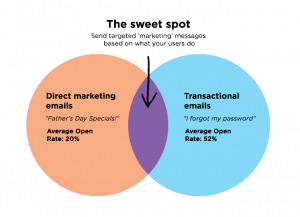Email marketing remains to be a powerful online marketing tool when properly executed. And while most A/E/C firms are using email marketing to communicate with clients and prospects, many aren’t necessarily seeing results and could use a boost.
Does your A/E/C firm suffer from low open and click-through rates for your email “blasts”? Do you receive a high number of unsubscribes with every email you send out, even emails sent specifically to clients? If so, you’re not alone! The good news is, by following some simple best practices you’ll see unsubscribes go down and your click-through rates go up. Best of all, your emails will have much more impact on clients and prospects alike. Here are 8 best practices to consider.
1. Grow your contact list organically
With email marketing lists, quality is preferred to quantity. While quantity is still important, you should aim to grow your lists organically, as purchased and rented lists (e.g. the conference attendee lists provided to exhibitors and sponsors) can often lead to a negative impact on your email sender reputation, deliverability issues and less than stellar results. (See this article on improving email deliverability) Your contact list should be populated with people who want and expect to receive your emails, such as clients, teaming partners, leads and other contacts that you’ve established some level of relationship with.
Here are some tips to help you grow your contact list organically:
• Include an email subscription form on your website
• Promote the subscription form with calls-to-action throughout your website and blog
• Add a link in your employees’ email signature that leads to the subscription form
• Regularly update your contact list with contacts in your CRM database
• Establish a process to regularly acquire new contacts from BD staff and “seller-doers”
• Collect email addresses at in-person events such as tradeshows, conferences and networking events
• Capture new contacts through webinar, whitepaper and eBook registrations
2. Segment your contacts
Many A/E/C firms send their entire list of contacts the same email blast, often in the form of a company eNewsletter or press release. Unfortunately, this approach creates what I call the “boy who cried wolf” syndrome, because it’s highly unlikely that the content of the newsletter is relevant to the entire list. And if your emails are consistently irrelevant to many of your contacts, they’re likely to grow accustomed to ignoring your emails altogether. This means when you do actually send them something valuable and relevant, they’ll ignore it because of your previous track record of sending them irrelevant emails.
So don’t make this mistake! Instead, segment your email contacts to target different groups so you can send them more relevant information. Consider segmenting your lists by category (clients, teaming partners, prospects, etc.), market (Commercial, Healthcare, Higher Ed, Municipal, etc.), service (site engineering, landscape architecture, interior design, etc.) or buyer persona (owners, influencers, etc.).
3. Match content to contact
For each segment, create email content that speaks directly to their interests and provides them with value. Perhaps you’ll want to educate them on a new industry trend, make them aware of a recent regulatory issue or speak about best practices related to their business challenges or needs. Your email content shouldn’t be one-size-fits-all; rather you should create specific content that is matched to specific contacts. The goal is to make your messages highly relevant and not only worth their time, but something they actually enjoy receiving and reading.
4. Design read-worthy emails
Your clients and prospects receive a ton of emails every day (probably many from other A/E/C firms like yours) so you have just mere seconds to persuade them to open and read your email. Needless to say, email design—everything from the subject line, to the graphics and the text—plays a big role in making or preventing that from happening.
Here are some tips to consider when creating your emails:
• Make sure your email is mobile-friendly
• Craft a compelling subject line that gets your emails opened
• Stick to your brand standards
• Keep your design clean, simple and uncluttered
• Less is more—don’t overwhelm with text
• Put key information at the top
• Include a call-to-action in every email
• Test your email in various platforms and proofread thoroughly
5. Rethink your company eNewsletter
A/E/C email marketing primarily consists of sending out monthly or quarterly firm eNewsletters. The problem with many company eNewsletters is they talk way too much about your firm, your accomplishments, your employees and your other clients! While this may be of interest to some, it’s likely not interesting to most, especially considering the “busyness” of business.
Thought leadership is really important in the A/E/C industry, so your eNewsletter should be more focused on educating and informing your clients and positioning your firm as a subject-matter expert in your field. And considering the need to segment your lists and be highly targeted with your messages, it might be best to move past the eNewsletter altogether and send shorter, more frequent, and more targeted emails to your various segments focused on one specific, relevant topic instead of the longer and less frequent eNewsletter.
6. Graduate to marketing automation software
The use of entry-level email marketing solutions like Constant Contact is pervasive across the A/E/C industry. While these programs offer decent features and an affordable price tag, they’re geared towards small businesses and their capabilities fall short for firms that want to get serious about email marketing. So perhaps the time has come for you to graduate to a more powerful email marketing solution and consider adopting a marketing automation platform.
Marketing automation software brings all your digital marketing tools—email marketing, social media monitoring, landing pages, web forms, lead management, conversion optimization, analytics, SEO and more—into one integrated platform. And it can greatly impact your A/E/C email marketing efforts by providing advanced features and tools (not found in basic email solutions) that help you easily create, test, optimize, deploy and measure your email campaigns.
7. Leverage drip campaigns for nurturing prospects and leads
According to a Genius.com study, 66% of B2B buyers indicate that “consistent and relevant communication” is a key influence in choosing a solution provider. The sales cycle in the A/E/C industry can last an extended period of time, often lasting several months to several years. So it’s important for your marketing (in addition to your business development efforts) to help your firm to stay engaged and top-of-mind throughout the “buyer’s journey.” And that’s where drip campaigns can be helpful.
Unlike batch-and-blast email marketing, drip programs offer an effective way to stay engaged with your targeted audience over an extended period of time. Email marketing drip programs (also known as drip campaigns, drip marketing, or automated programs) leverage marketing automation software to send a targeted list of contacts a set of email messages based on predefined time intervals, actions taken by the contact (such as website visits, content downloads, etc.) or a combination of both. They allow marketers to stay connected to their contacts, provide those contacts with targeted and relevant content, while also reducing the time and effort needed by the marketing department to manage the program.
8. Monitor, measure and optimize
Keeping a close eye on the results of your email marketing campaigns is critical to the success of your ongoing efforts. You should be looking for insights into what contributed to the success (or failure) of each email and apply those insights to future efforts. You’ll want to keep a close eye on the following metrics:
• Delivery rate / bounce rate
• Open rate
• Click-through rate
• Unsubscribes / spam reports / hard bounces
• Opens / clicks by device type
Based on insights gleaned from campaign results, your approach should be optimized and tweaked moving forward. Consider using A/B (split) testing to experiment with different email options (i.e. subject lines, time of day, from address, colors, call-to-action) and determine which will be the most effective. Email marketing success is a moving target and your approach should be in a mode of continuous improvement.
Leverage the power of email marketing
There’s a lot more that A/E/C firms can do to leverage the power of email marketing. While certainly not an exhaustive list, these 8 best practices should provide you with some ideas to start improving your firm’s email marketing efforts today.
Digital & Social Articles on Business 2 Community(110)
Report Post








